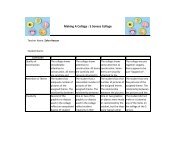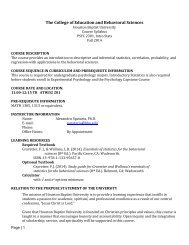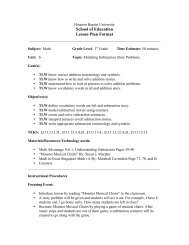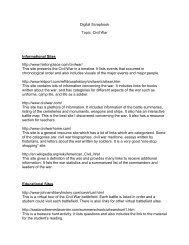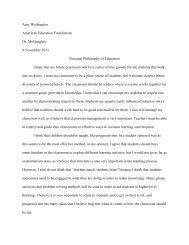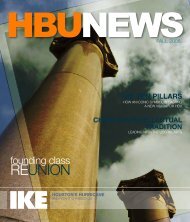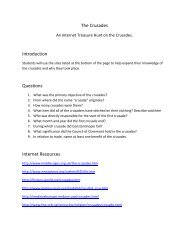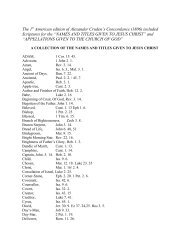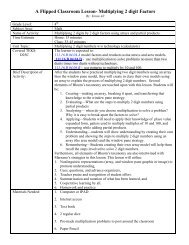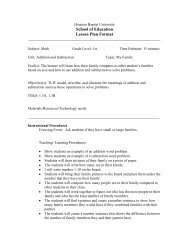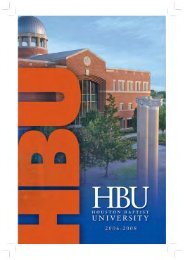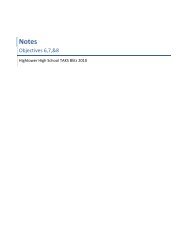Peer Coaching Action Research Paper - Houston Baptist University
Peer Coaching Action Research Paper - Houston Baptist University
Peer Coaching Action Research Paper - Houston Baptist University
Create successful ePaper yourself
Turn your PDF publications into a flip-book with our unique Google optimized e-Paper software.
Running Head: THE PEER COACHING PROCESSThe <strong>Peer</strong> <strong>Coaching</strong> ProcessCaroline L. BurdettEDUC 5305Dr. Dawn Wilson<strong>Houston</strong> <strong>Baptist</strong> <strong>University</strong>November 29, 2010
The <strong>Peer</strong> <strong>Coaching</strong> Process 2The <strong>Peer</strong> <strong>Coaching</strong> ProcessThe purpose of this research study is to examine the effect of peercoaching on the implementation of technology in the classroom. Theaction research study was conducted under the framework of graduatestudent coursework and took place in an affluent private school in<strong>Houston</strong>, Texas. Three colleagues were assisted in the implementation oftechnology in the classroom and curriculum. Two research questions wereinvestigated regarding the effects of peer coaching on (1) theimplementation of technology in the classroom, and (2) the teacher’sapproach to curriculum planning as a result. The researcher concluded thepeer coaching program had a positive effect on both areas investigated.IntroductionWikis and Vokis and WebQuests, oh my! To some, the terminology of technology itselfcan be intimidating. To understand what these different technology tools are, what they have tooffer, and how to successfully implement them in the classroom, is another issue to tackle. As agraduate student with a strong emphasis in instructional technology, I understand the value ofteaching with technology, and I have noticed the lack of its application on my campus. Perhapsit is the fear of the unknown – or perhaps the safety of the known – that keeps teachers fromexploring the dynamic world of technology tools. Or perhaps it is simply the lack of guidanceand support in how to integrate technology that inhibits its integration into the curriculum andthe classroom.Local ContextThe peer coaching action research was conducted within a private school institution,River Oaks <strong>Baptist</strong> School, in <strong>Houston</strong>, Texas. As a Fifth and Sixth grade Spanish teacher andfaculty member of the private school, I am aware of the challenges that colleagues with variedlevels of experience can encounter in the ever-advancing field of instructional technology.
The <strong>Peer</strong> <strong>Coaching</strong> Process 3While a growing interest in these tools exists among the faculty, so also exists a hesitancy, lackof time, lack of training, and lack of skill to utilize the technology. As a graduate studentworking toward a Master in Education degree in Curriculum and Instruction with aSpecialization in Instructional Technology, I am especially knowledgeable about the toolsavailable to increase student engagement and meaningful learning with technology. I thereforerealize that I have worthwhile expertise to share with my colleagues, and a responsibility toencourage others to embrace and to implement technology teaching tools successfully.Literature Review<strong>Peer</strong> coaching is a collegial process in which to improve and expand upon teachingtechniques (Hunt & Weaver, 2008). A peer coaching program can be categorized as one-way, inwhich one colleague serves as coach and the other as recipient, or two-way, a more reciprocalform involving colleagues coaching each other (2008).The form of a peer coaching program can change according to the needs, purposes, andgoals for the coaching; however, the overall goal remains the same: to improve instructionalstrategies in order to best meet the needs of students (Kohler & Crilley, 1997). The type ofmentoring model should be selected according to the needs of the institution or school, and theemphasis on how to enhance the integration of technology into a program or curriculum(Chuang, Thompson, & Schmidt, 2003). Before beginning a peer coaching program, however, aneeds assessment and analysis for instruction should be conducted by the mentor in order toestablish the overall vision, as well as to set both short- and long-term goals for the teacher(s)(Kopcha, 2010).
The <strong>Peer</strong> <strong>Coaching</strong> Process 4Chuang, et al. (2003) identify four types of professional development models in whichgraduate students serve as mentors as part of their course field work, undergraduate studentsserve as mentors to inservice teachers, instructional technology students serve as mentors in a K-12 institution, or secondary school students serving as mentors in collaboration with the teacherin their classroom. Common themes for success among these four mentoring models includeproviding visions for technology use, individualizing support, breaking down the hierarchicalstructure, establishing dialogue and collaborative relationships, providing mutual benefits, andestablishing learning communities (2003).Another example of professional development through coaching is a systems-basedmodel of mentoring. In this model, the coaching process of technology integration unfolds infour stages: (1) initial set up in order to minimize and troubleshoot potential problems; (2)preparation of the teacher for student-centered uses of technology; (3) curricular focus andpedagogical guidance in student-centered technology integration; and (4) a shift away frommentor-led system to a more inclusive community of practice (Kopcha, 2010). This four-stageprocess not only helps to promote more student-centered learning in the classroom, but alsoaddresses how a mentor or coach can effectively negotiate the barriers on teachers, such as time,beliefs, access, and culture (2010).The benefits of professional development for the integration of technology arehighlighted in literature and research conducted on peer coaching programs (e.g., Huston &Weaver, 2008; Chuang, et al., 2003; Kohler & Crilley, 1997; Showers & Joyce, 1996). In theirresearch on the effects of peer coaching on teacher and student outcomes in different settings,Kohler & Crilley (1997) identify three common benefits of peer coaching to be the procedural(technical) support, affective (emotional) support, and reflective support the coaches provided
The <strong>Peer</strong> <strong>Coaching</strong> Process 5the teachers. For experienced faculty, specifically, peer coaching provides an opportunity tomeet professional development needs, to reflect upon and revitalize teaching practices, toimprove pedagogical and content knowledge, and to give back (Hutson & Weaver, 2008).As previously noted, peer coaching programs for professional development can vary.That being said, common recommendations for an effective program emerge in the literature andresearch on peer coaching (e.g., Hutson & Weaver, 2008; Glazer, Hannafin, & Song, 2005;Chuang, et al., 2003; Slater & Simmon, 2001; Kohler & Crilley, 1997). Key criteria for asuccessful peer coaching program include a commitment to work toward a common goal,voluntary participation, sufficient training for the coaches, scheduled time during school hoursfor collaboration, a nonevaluative and nonjudgmental approach, and a level of trust and mutualrespect among participants (Latz, Neumeister, Adams, & Pierce, 2009; Hutson & Weaver, 2008;Glazer, et al., 2005; Wong & Nicotera, 2003; Slater & Simmon, 2001; Kohler & Crilley, 1997).Overall, an effective peer coaching program should focus on improving teaching (Slater &Simmon, 2001) in order to best meet the needs of students.<strong>Research</strong> QuestionsTo preface the peer coaching assignment, it was necessary to identify specific researchquestions to be addressed through the peer coaching process. Of particular interest was:1. If I invest time in coaching colleagues for technology integration, in what ways willthey implement the new knowledge in their curriculum?2. How will a teacher’s approach to curriculum planning change as a result of beingcoached in the use of technology?
The <strong>Peer</strong> <strong>Coaching</strong> Process 6MethodsParticipantsAs a peer coach I assisted three middle school colleagues, each a teacher with variedcontent areas and levels of technology skill. Each colleague expressed a strong desire toincorporate technology into the curriculum and was a voluntary participant in the peer coachingprogram. My overall goal was to assist each colleague in exploring various lessons or units inwhich technology could facilitate more student engagement and more meaningful learning. Inaddition, our shared goals were to identify and to learn specific tools to use for effectiveinstruction and student-centered activities in the classroom.Table 1 provides specific information about each participant assisted through the peercoaching program, including total years of teaching experience, current grade and subject taught,and a self-evaluated technology skill level on a scale of 1 (low) to 5 (high).Table 1: Overview of participantsColleagueOneColleagueTwoColleagueThreeTotal Years ofTeaching ExperienceCurrent Grade Level andSubject TaughtLevel of TechnologyExpertise (self-rated)4 years 6 th Gr. Earth Science 414 years 6 th & 7 th Gr. Spanish 1A & 1B 2.5 – 35 years 6 th Gr. English 3ProceduresInitial meetings conducted one-on-one with each participant consisted of informingparticipants in detail about the purpose of the peer coaching program and action research.Participants evaluated their own initial skill level of technology on a scale of 1 (low) to 5 (high).
The <strong>Peer</strong> <strong>Coaching</strong> Process 7Journal entry questions (Appendix A) completed by the participants following the initial meetingprovided additional information in regard to the specific goals of the participant, including whatthe individual would like to accomplish through working with the peer coach. Table 2 providesin each colleague’s own words her goal for the peer coaching process.Table 2: Overview of participants’ goalsColleagueOneColleagueTwoColleagueThreeResponse to Journal No. 1 Question:―What do you hope to accomplish during this coaching session this semester?―I hope to integrate new and fresh technology ideas in my science curriculum.I hope to find ways to help my students use interactive websites/activities toexpand their knowledge of science. I want to learn to use technology as amethod to model the earth to allow students to virtually explore science. I alsohope to find a fresh, new way of taking and presenting notes to students.‖―Having someone to help me to incorporate more technology in the classroomwill decrease the amount of time that I would need to invest in researchingresources and learning them on my own.‖―Since I am generally unaware of the technology available to me, I’mparticularly interested in learning more about that! I also want to know how Ican take some of my lessons and activities and adjust them so that I’m utilizingthe technology available to me and making them more engaging to mystudents.‖Additionally, each colleague made note of specific units or curricular objectives in whichthe teacher felt student learning would be enhanced through the integration of technology. Uponthe insight provided from the initial meetings, conversations, and journal entries, the researcherbrainstormed ideas for each colleague as a starting point for the peer coaching process. Table 3provides an initial summary of technology tools brainstormed and/or researched for eachcolleague upon beginning peer coaching process.Each investment of time on the researcher’s part was documented on an Excelspreadsheet to record the steps and tasks addressed along the way. Documented internship hours
The <strong>Peer</strong> <strong>Coaching</strong> Process 8consisted of time spent planning, researching, creating, and assisting in the implementation oftechnology tools for the three colleagues.Table 3: Initial brainstorming of technology toolsBrainstorming of Technology Tools after Initial MeetingsColleagueOneColleagueTwoColleagueThreePrezi.com – Way to present notes to studentsGlogster EduAnimotoInterest in Photostory or similar productQuia.com/web – Way to encourage additional practice at home and forstudents to check for understandingGlogster EduInterest in AnimotoInterest in VokiPrezi.com – Way to present notes to studentsInterest in Discussion thread of school website and wikiInterest in AnimotoGlogster EduSubsequent meetings with each colleague varied in consistency due to different schedulesamong the peer coach and colleagues. In between meetings spent teaching the technology tools,the peer coach maintained consistent contact with coachees. The ongoing communication servedas a way to determine any unforeseen issues that may have emerged, as well as to encourage andto motivate colleagues to follow through with plans. These ―check ins‖ became a strategicmethod to hold both the peer coach and coaches accountable for planned activities andimplementation.A large amount of time was spent as a peer coach in investigating alternatives andresearching various tools to share with colleagues. With a broad knowledge of technology toolsand resources readily available to share, I felt a responsibility to identify and to understandcolleagues’ needs, and to provide them with tools that would meet their curricular goals and
The <strong>Peer</strong> <strong>Coaching</strong> Process 9objectives. It was necessary, then, to spend outside time to explore and to become familiar withnew tools that would effectively meet colleagues’ curricular objectives. For example, I waspreviously unfamiliar with the Web 2.0 tools Glogster Edu and Prezi, however I becameknowledgeable about their features and was therefore able to instruct my colleagues in how tonavigate the tools and utilize them in a classroom setting.As an additional means of support, instructional guides were created and tailored to eachcolleague’s needs, providing directions for working with tools such as Glogster Edu (AppendixB) and Prezi (Appendix C). These supplementary resources can serve as a reference guide forfuture use of these tools as well. While the time necessary for gathering information andcreating these tutorials was demanding, they proved to be valuable resources for both the peercoach and coachees. Additionally, these guides can be easily reformatted to serve as a studenthandout, which was beneficial for Colleague Three when introducing the Glogster Edu tool inclass.One-on-one time with colleagues was dedicated to guiding them in setting up educatorand/or student accounts for the various technology tools. I created and shared a template witheach colleague providing a visual reference for how to efficiently document student log ininformation for Quia.com/web and Glogster Edu (Appendix D). The template provided anexample to reference for procedural logistics when implementing technology tools in the future.Additional assistance was provided to each colleague depending on their needs. Theseneeds were assessed through dialogue, as well as subsequent journal entries completed by thecoachees throughout the peer coaching process. For example, Colleague One expressed a needfor help in finding images to use in an Animoto video. While the need for these resources wasmet, further assistance was provided in teaching her how to find useful images for projects,
The <strong>Peer</strong> <strong>Coaching</strong> Process 10thereby providing her the knowledge to do so on her own in the future. Colleague Twobenefitted from assistance in determining specific criteria to include for a student project usingGlogster Edu, as well as in creating a suitable rubric for evaluation of students’ work. ColleagueThree identified a need for an in-class demonstration of Glogster Edu to her students as anexample of how to introduce the tool to other classes. In working closely with these colleaguesand maintaining communication through dialogue and journal entries, individualized needs wereidentified and fulfilled. The one-on-one assistance provided instruction and additional assistancewith reference guides and strategies to use in the future.Table 4 outlines the technology tools addressed with each colleague in the peer coachingprocess. Not only were these tools selected and implemented to meet the curricular needs of theparticipants, but they were also further discussed as to how they might be utilized effectivelyTable 4: Technology tools addressed in peer coaching processColleagueOneColleagueTwoColleagueThreeTechnology Tools Implemented and/or Addressed for Lesson PlanningPrezi.comGlogster EduAnimotoAdobe Multimedia (lesson planning for future use)WebQuests (lesson planning for future use)Quia.com/webGlogster EduVoki.comGlogster EduAnimotoMultimedia gamesPowerPoint games (lesson planning for future use)Webquests (lesson planning for future use)with future lessons and curricular objectives. Table 5 provides specific information regardingthe tasks integrated by coachees, as well as feedback and reflection of their effectiveness.
The <strong>Peer</strong> <strong>Coaching</strong> Process 11Table 5: Overview of technology tasks and feedbackTechnology Task Task Information Feedback / ReflectionColleagueOneColleagueTwoPrezi.comGlogster EduAnimotoQuia.com/webGlogsterVoki.comGlogster Coachee created unitintroduction piece Students will create virtualnews story (activityplanned for future lesson) Create short video for unitwrap-up Established studentaccounts by class Created vocabularypractice activity Created online quiz Students created interactiveposter for HispanicHeritage presentation Students will create avatarsto practice pronunciationand intonation (activityplanned for future lesson) Students created interactiveposter for presentation Some minor glitches increating presentation; <strong>Peer</strong>coach assisted introubleshooting Kept student attention Will use again in future Predicts students willcreative way to presentnews story Students enjoyed video Quick, easy unit review Any activity that usestechnology is welcome,despite any frustrations orissues that may arise (i.e.,student accounts andpasswords) Students able to showcreative side and learnabout Hispanic culture Tool itself is not difficultto use; it is the time spentresearching and exploring Students are excited aboutprojectsColleagueThreeAnimotoMultimediagames Coachee will create shortvideo introducing writingassignment for new unit(task planned for futurelesson) Students will playinteractive games related tonovel (activity postponeddue to unplanned teacherabsence; will beimplemented in nearfuture) Coachee is excited aboutthe imaginative way tointroduce new unit Coachee’s goal is to showstudents that educationalgames can be fun It is important for studentsto have fun while learning
The <strong>Peer</strong> <strong>Coaching</strong> Process 12ResultsThe action research peer coaching assignment was designed to investigate whetherteachers would be more inclined to integrate technology if provided a peer coach to guide,support, and encourage them along the way; and if so, would their approach to curriculumplanning change as a result? These questions were answered over the course of the peercoaching process. Further insight was provided through journal entries completed by eachcolleague, as well as my own reflections documented throughout the process.ReflectionsThe journal entry reflections completed by the participants provided valuable feedbackfor me regarding the progress of the peer coaching process, as well my own personal progress asa peer coach.As a peer coach, I learned how to present technology tools to my colleagues with a userfriendlyattitude and approach. In the beginning of the peer coaching program, my colleaguesshared that they would like to incorporate more technology into their curriculum, but they wereoften hesitant to do so. I was able to successfully negotiate these barriers of intimidation andlack of time to explore and learn on their own by conducting a needs assessment. Afteridentifying my colleagues’ needs, I was able to establish a focus and direction for achieving ourgoals. This also meant determining their comfort level with technology in order to build or tocultivate confidence in its future implementation.I realized that as a peer coach it was important to make technology seem moremanageable for my colleagues. The time I spent researching tools and creating instructionalguides and tutorials was well worth the effort. My colleagues shared that these resources helped
The <strong>Peer</strong> <strong>Coaching</strong> Process 13to break the technology tool down into manageable pieces, thereby removing the daunting natureof the task.At the conclusion of the peer coaching program, I asked my coachees to provide a secondself-rating about their technology skill level. This follow-up question yielded a clear, direct wayto interpret their feelings of the progress made and the confidence built through ourcollaboration. Table 6 provides a before-and-after skill level comparison as rated by theparticipants.Table 6: Before-and-after comparison of technology expertiseColleagueOneColleagueTwoColleagueThreeBefore:Level of TechnologyExpertise (self-rated)42.5 – 3After:Level of TechnologyExpertise (self-rated)4(but closer to a 5)new self-rating notprovided3 4 – 4.5This is not to say, however, that everything went smoothly during the action research. Iencountered obstacles in finding mutual time to collaborate with my colleagues. Through ourconversations and in reading their reflections, I realize that my coachees, too, felt the pressure ofa limited time frame in which to implement the technology. In my review of peer coachingliterature and research, the element of time was repeatedly mentioned as an important elementfor a successful peer coaching program. I felt the constraint of time contributed to a constraint ofpossibilities.I was also struck by my initial hesitancy to ―assign‖ work to my colleagues. Knowing
The <strong>Peer</strong> <strong>Coaching</strong> Process 14the demands of our schedules and outside commitments, I felt awkward assigning them a task,but knew it was important for them to explore and utilize their new knowledge on their own.The pressure of completing specific tasks within a short time frame further exasperated thisfeeling.As a peer coach, I felt inspired by the enthusiasm with which my colleagues approachedlearning how to implement new technology tools in the classroom. I realize now even more howmuch I have learned throughout my graduate program how to effectively teach with technology,and was I genuinely enthusiastic to share my knowledge with others. Despite obstacles of timeand schedules, I feel I was able to effectively guide and assist my colleagues as a peer coach.My personal experience as a peer coach and the experiences and reflections provided bymy coachees, lead me to believe that the peer coaching process has a positive effect on theintegration of technology. My coachees implemented (or intend to implement) a variety of tasksand activities which proved to be successful for instruction and meaningful student learning.Despite the limited time frame in which to collaborate, I feel we were able to accomplish a greatdeal, and that my guidance and assistance has helped to establish a foundation for my colleaguesin teaching with technology. On an additional note, I have personally committed to work withmy coachees for the remainder of the year in order to facilitate continued growth inimplementing technology in the classroom.Final ReflectionsSuccessful integration of technology does not require a complete overhaul of classroominfrastructure. A well-equipped classroom is nothing more than smoke and lights if thetechnology it is not integrated effectively in order to unleash its potential and the potential of the
The <strong>Peer</strong> <strong>Coaching</strong> Process 15learners. Maximum student achievement is related to maximum engagement and meaningfullearning in the classroom. In order to make learning meaningful, then, it is necessary forteachers to understand where their students are coming from and how to help and to equiplearners to go from there. The same concept applies to the peer coaching process: it is necessaryfor peer coaches to understand where their coachees are coming from and how to help and toequip them to effectively integrate technology in the curriculum and classroom.In order to facilitate a technology-integrated learning environment, it is imperative toprovide time to teach colleagues about what tools are available, how to use them, and how toadvance their own knowledge of the effective integration of technology in their curriculum.Encouragement and motivation for peer coachees should be consistently provided by both thepeer coach as well as school administration. According to Showers & Joyce (1996), it is of greatimportance for the school to adopt a community-wide, collaborative culture of coaching in orderto achieve greater professional development within the organization.
The <strong>Peer</strong> <strong>Coaching</strong> Process 16ReferencesChuang, H., Thompson, A., & Schmidt, D. (2003). Faculty technology mentoring program:Major trends in the literature. Journal of Computing in Teacher Education, (19)4, 101-106.Glazer, E., Hannafin, M., & Song, L. (2005). Promoting technology integration throughcollaborative apprenticeship. Educational Technology <strong>Research</strong> & Development, 53(4),57-67. Retrieved from Psychology and Behavioral Sciences Collection database.Huston, T. & Weaver, C. (2008). <strong>Peer</strong> coaching: Professional development forexperienced faculty. Innovative higher education, 31(1), 5-20. Retrieved August 30,2010, from ERIC database.Kohler, F., & Crilley, K. (1997). Effects of peer coaching on teacher and studentoutcomes. Journal of Educational <strong>Research</strong>, 90(4), 240. Retrieved from ProfessionalDevelopment Collection database.Kopcha, T. (2010). A systems-based approach to technology integration using mentoringand communities of practice. Educational Technology <strong>Research</strong> & Development, 58(2),175-190. doi:10.1007/s11423-008-9095-4.Latz, A., Neumeister, K., Adams, C., & Pierce, R. (2009). <strong>Peer</strong> coaching to improveclassroom differentiation: Perspectives from project CLUE. Roeper Review, 31, 27-39.doi: 10.1080/02783190802527356.Showers, B., & Joyce, B. (1996). The evolution of peer coaching. Education Leadership,53(6), 12-16. Retrieved from ERIC database.Slater, C., & Simmon, D. (2001). The design and implementation of a peer coaching
The <strong>Peer</strong> <strong>Coaching</strong> Process 17program. American Secondary Education, 29(3), 67-76. Retrieved from ERIC databaseon September 26, 2010.Wong, K., & Nicotera, A. (2003). Enhancing teacher quality: <strong>Peer</strong> coaching as aprofessional development strategy. A preliminary synthesis of the literature. (Report No.5). Washington, DC: Institute of Education Services. Retrieved fromhttp://www.temple.edu/lss/pdf/publications/pubs2003-4.pdf.
The <strong>Peer</strong> <strong>Coaching</strong> Process 18Appendix AColleague 1: Journal entries(Journal No. 1)1. What do you teach?I teach 6 th grade earth science.2. How long have you been teaching?This will be my 5 th year teaching. 2 years at public school teaching 4 th grademath/science and this will be my 3 rd year of 6 th grade science.3. What kind of access do you have at work? At home?I have 2 computers at home with internet access on both. I have access to all my workfiles and email from home. I have up to date software on all computers.4. What do you hope to accomplish during this coaching session this semester?I hope to integrate new and fresh technology ideas in my science curriculum. I hope tofind ways to help my students use interactive websites/activities to expand theirknowledge of science. I want to learn to use technology as a method to model the earthto allow students to virtually explore science. I also hope to find a fresh, new way oftaking and presenting notes to students.5. What should your coach know about you?I look forward to learning new technology and sprucing up my curriculum!(Journal No. 2)1. What seems most exciting about using technology?I am excited to liven up a unit in an interesting way that can become slow and drag.2. What are you the most nervous about when you consider technology use by you oryour students? What contingencies do you have set up?Any teacher worries that the students’ will lose interest or focus when a new idea isimplemented. Also, all teachers worry that if the students are asked to use the technologythat the program or computer with have problems or that the students will not understandthe lesson and be confused. I worried with animoto that they would not pay attention tothe short video.3. What will be your first technology integration piece? Describe how and what youplan to do (along with the help of your coach). I have created a short 30 second videoto review minerals using Animoto.com. I created the video using animoto with picturesof some of the minerals my students had learned. My peer coach showed me one of heranimoto videos she had created for class so I could see an example. She also helped findpictures on the internet for me to use. We brainstormed uses for this technology.4. How did it go? What can be improved?I believe the introduction of animoto went well. I only used it as a way to quickly review
The <strong>Peer</strong> <strong>Coaching</strong> Process 19the unit we were wrapping up. I do regret that it was such a short video (30 seconds)because it felt too brief. I am interested in purchasing the upgrade so that I can havelonger videos.5. How did the students react? Positive/Negative/discipline problems?The students enjoyed the video and enjoyed having a quick easy overview to review theunit.(Journal No. 3)1. What did you plan for your second technology integration piece?I created a prezi presentation to introduce a unit.2. What did you have to create to implement the technology?I had to create the prezi presentation using prezi.com and downloading pictures to insertin the presentation.3. How did the coach help you?My peer coach sent me a tutorial to help me understand the basics of the new technologybefore I began working with prezi. Caroline also helped search the internet for picturesfor me to insert in the presentation. I had a few minor problems with prezi and Carolinewas able to help me sort of the minor glitches and finish my presentation.4. How did it go in class? Was it successful? Did it all work the way you intended itto?My students found it intriguing to use such a different tool than powerpoint. They likedthe movement and it kept their attention.5. What would you change next time?Next time I will add more information to the presentation and change a little of the way Iformat the presentation so it was more interesting. This was a test to see how thestudents would react and if the technology would work for the use I intended it to work.6. How did the technology integration coach help you?My peer coach also suggested that I use it as a whole class review. I think this is a greatidea. The technology may be too much for my 6 th graders, but we could create a prezi asa class for a review.(Journal No. 4)1. Describe your final technology integration piece. How did it go?I will be implementing the final technology piece in the spring with a unit that it will bebest suited. I will have my students use glogster to create a virtual news story over aspecific volcano. I think the students will enjoy having creative way to create and presenttheir news story.2. Are there any plans you have for future technology integration?
The <strong>Peer</strong> <strong>Coaching</strong> Process 20As answered in #1, I plan to use glogster in the spring semester. I also plan to use preziin a few weeks as a review for the current rock unit.3. Describe the coaching process from your perspective.I feel it is a great way to have teachers share ideas and use new and exciting technology.It also gave me a reliable, knowledgeable person to ask questions and receive help withtechnology issues.4. Was this a beneficial way to learn more about using technology?Yes, I believe it helped me find new technology that I did not have the time to find ortime to learn how to use by myself. It was also someone to bounce ideas off of that knewthe technology so she had an understanding of the capabilities and uses.5. What advice would you give others about technology coaching?I felt it was incredibly beneficial to me to have this expert help with me see my lessonsdifferently.6. How has technology coaching affected your teaching and learning?It has helped me look at the units I teach in a different way. It gave me ideas that I wouldnot have thought of on my own.7. What suggestions do you have for future projects of this type?I did feel that we were short on time. I wish the peer coaching could be over the wholeyear so we had time to find the right unit for each technology application.Additional question asked by peer coach:At the beginning, you rated yourself a 4 on a scale of 1-5 for technology skills. (5being the highest.) After participating in this experience, how would you rateyourself now on a scale of 1-5?I feel I am still a 4, but closer to a 5.
The <strong>Peer</strong> <strong>Coaching</strong> Process 21Colleague 2: Journal entries(Journal No. 1)1. What do you teach?Currently, I teach Spanish 6 th and 7 th grade at River Oaks <strong>Baptist</strong> School2. How long have you been teaching?I have been teaching for 14 years of which I have taught 13 years at the high school level3. What kind of access do you have at work? At home?I you mean access to technology; I have a projector, a desktop and a laptop available toteach. I also have a stereo and a document camera.4. What do you hope to accomplish during this coaching session this semester?Having someone to help me to incorporate more technology in the classroom willdecrease the amount of time that I would need to invest in researching resources andlearning them on my own.5. What should your coach know about you?I like to bring new ideas to the classroom, I like innovation, and I am flexible in terms ofhow to blend new ideas with the current curriculum.(Journal No. 2)1. What seems most exciting about using technology?Having a mentor. The fact that I don’t have to spend hours and hours trying to learn howto use an application/program, makes me more willing to implement it in my lessons.2. What are you the most nervous about when you consider technology use by you oryour students? What contingencies do you have set up?Technology doesn’t make me nervous. However, I when the students have to do anassignment at home, I have to think about compatibility problems. My contingency planis to be more flexible in terms of deadlines. I don’t have control of what happens outsidemy classroom, but I can help the kids if they are at school. I know the technologydepartment is always ready to help.3. What will be your first technology integration piece? Describe how and what youplan to do (along with the help of your coach).Perhaps this questions needs to be rephrased. This questions implies that technologyhasn’t been integrated in my lessons previous this mentoring program or that thisintegrations is just beginning to take place now. I have integrated technology in mylesson in the past. One example is the QUIA website used to practice vocabulary.4. How did it go? What can be improved?(No response provided by coachee.)5. How did the students react? Positive/Negative/discipline problems?Let’s not forget that our students are technology natives. Anything activity that usestechnology is welcome, despite the small frustrations about passwords, etc.
The <strong>Peer</strong> <strong>Coaching</strong> Process 22(Journal No. 3)1. What did you plan for your second technology integration piece?To create an online poster, using www.glogster.com.2. What did you have to create to implement the technology?I used an all lesson about Hispanic Heritage Month.3. How did the coach help you?My coach did all the research about creating accounts for the students and how tonavigate the site to create the poster.4. How did it go in class? Was it successful? Did it all work the way you intended itto?In class we had only minor problems with passwords at home. Some kids type thepassword incorrectly. A few kids had problems posting the link for one of the parts ofthe glogster.5. What would you change next time?To work in class on the parts the kids had problems this year.6. How did the technology integration coach help you?I think I answer this question under #3. My coach and I kept active communicationduring this project. She came to my class to show me how to solve the problem with thelink.(Journal No. 4)1. Describe your final technology integration piece. How did it go?The objective was accomplished. Students had fun while learning. Glogster.com allowedstudents to show their creative side while learning about the Hispanic culture.2. Are there any plans you have for future technology integration?Yes, I will be using the VOKI site to practice pronunciation and intonation.3. Describe the coaching process from your perspective.It worked very well. I had some clear ideas about what I wanted to do, a list of questionsand objectives. This made easier to work with my coach.4. Was this a beneficial way to learn more about using technology?Yes, with a clear task in mind, it’s easier to be more productive and accurate.5. What advice would you give others about technology coaching?Be opened minded and don’t waist a great opportunity to enhance your teaching throughtechnology.6. How has technology coaching affected your teaching and learning?
The <strong>Peer</strong> <strong>Coaching</strong> Process 23I want to clarify that this is not the first time I am using technology. I took thisopportunity as an opportunity to explore some other programs that exist out there. Themost beneficial things about technology coaching was the amount of time I saved byhaving someone else surf the web to find a new teaching tool.7. What suggestions do you have for future projects of this type?Any new project needs to be plan weeks ahead of time, since the implementation meansadjusting the lesson and in most cases showing the students how to use the new internetbased program.Additional question asked by peer coach:At the beginning, you rated yourself a 4 on a scale of 1-5 for technology skills. (5being the highest.) After participating in this experience, how would you rateyourself now on a scale of 1-5?I learned about 2 new internet based programs, and I had a refresher about one. It is hardto know exactly what is meant by technology skills. Technology covers more than justthe internet. Again, the most time consuming thing is to surf the web to find newprograms to be incorporated in the lessons. The use of these programs--GLOSTER,VOKI AND QUIA, is not difficult in itself.
The <strong>Peer</strong> <strong>Coaching</strong> Process 24Colleague 3: Journal entries(Journal No. 1)1. What do you teach?I teach 6 th Grade English Workshop, which is a course specifically designed to buildreading and writing skills. I also teach 8 th Grade Language Arts.2. How long have you been teaching?This is my 6 th year to teach.3. What kind of access do you have at work? At home?Access to technology? At home I have a laptop and use it occasionally to enter grades,but I generally do most of my work at school, where I have a desktop computer, a laptop,laptops for my students to use, and a projector.4. What do you hope to accomplish during this coaching session this semester?Since I am generally unaware of the technology available to me, I’m particularlyinterested in learning more about that! I also want to know how I can take some of mylessons and activities and adjust them so that I’m utilizing the technology available to meand making them more engaging to my students.5. What should your coach know about you?I’ve got an open-mind about technology but am often intimidated by it!(Journal No. 2)1. What seems most exciting about using technology?I’m excited to use technology to enhance my students’ learning. I’m always trying tofind new, hands-on ways to capture their attention and get them excited about a subject ora project.2. What are you the most nervous about when you consider technology use by you oryour students? What contingencies do you have set up?I’m somewhat nervous about not knowing enough about the technology I’m asking mystudents to use to help them through the process. I’m fortunate to have colleagues whocan help me with technologies that are new to my students and to me.3. What will be your first technology integration piece? Describe how and what youplan to do (along with the help of your coach).I’ve just started a project with my students which involves research and a presentation.In years past, students have done presentations with PowerPoints or posters they’d made.This year, with the help of my coach, I’m having my students do the presentation andmake interactive posters using Glogster. I’ve already introduced my students to theassignment and demonstrated how to use Glogster, and in the coming days and weeks,my students will be able to create their own posters using this tool.4. How did it go? What can be improved?So far, everything has gone well. My coach has been extremely helpful and informative,
The <strong>Peer</strong> <strong>Coaching</strong> Process 25and my students are so excited about the prospect of using Glogster. The only issues thusfar have been with the Glogster website, which occasionally has problems.5. What did the students react? Positive/Negative/discipline problems?The students are excited about their projects, and all feedback from them has beenpositive!(Journal No. 3)1. What did you plan for your second technology integration piece?After my students complete a project using Glogster for the novel they’re currentlystudying, I will introduce another writing assignment, which I will introduce with a shortvideo I’m making using Animoto.2. What did you have to create to implement the technology?I’m in the process of creating the video. This next unit will focus on personal memoirwriting, so my video introduction will give the students a glimpse into what personalnarrative writing is all about.3. How did the coach help you?My coach, Caroline Burdett, showed me how to use Animoto. She also showed me someexamples of the short videos that she’s made for her Spanish classes. She actually gaveme the idea of using this tool to introduce a unit. I loved the idea—and the examples sheshowed me—because I often struggle to come up with imaginative ways to introducenew units to my students.4. How did it go in class? Was it successful? Did it all work the way you intended itto?As this unit will begin in the upcoming weeks, I have not shown my video to my classesyet, but I’m confident that the video I create will hook them and make them excited aboutthe memoir.5. What would you change next time?I wouldn’t change anything so far.6. How did the technology integration coach help you?As mentioned above, Caroline has made herself fully available, showing me how to usethis tool, showing me examples of how she has used it, and encouraging me to come toher for help.(Journal No. 4)1. Describe your final technology integration piece. How did it go?My last technology piece, interactive, educational games related to the novel Holes byLouis Sachar, was supposed to be implemented last week; however, I had an unplannedtwo-day absence, so I could not introduce this lesson to my students. I plan to do so afterthe Thanksgiving Break. My main goal in introducing my students to these games is to
The <strong>Peer</strong> <strong>Coaching</strong> Process 26show them that educational games can be fun. I feel that it's important for students tohave fun while learning.2. Are there any plans you have for future technology integration?Absolutely! I plan to use all of the tools that my coach, Caroline Burdett, showed me,and I plan to come to her throughout the school year when I have a unit or lesson that Ithink could be improved with technology.3. Describe the coaching process from your perspective.Caroline is an excellent coach. She's patient and thorough, two attributes that reallyhelped me see the importance of implementing new technology in my curriculum. I'mthe type of person who loves the idea of using new technology (as I recognize that it trulyis the future of education) but who is intimidated by it. Caroline was able to show menew technological tools that are accessible and fun. She was able to walk me through thesteps of each new type of technology that she showed me. I feel very confident nowabout using new technology in my classroom.4. What this a beneficial way to learn more about using technology?Yes! One-on-one, hands-on instruction is always best!5. What advice would you give others about technology coaching?I would suggest that other coaches walk their "students" through each new piece oftechnology as Caroline did for me. Also, it was very helpful to see how Caroline usedtechnology in her own classroom. When I saw the interactive maps that she madethrough Glogster and the videos that she made through Animoto, I was able to gain aclear picture of how I could adopt these tools for my own curriculum. I think that othercoaches should "model" how they've used the technology themselves.6. How has technology coaching affected your teaching and learning?I am no longer intimidated by it!7. What suggestions do you have for future projects of this type?No suggestions! I think that my coach, Caroline, did an exemplary job.Additional question asked by peer coach:At the beginning, you rated yourself a 4 on a scale of 1-5 for technology skills. (5being the highest.) After participating in this experience, how would you rateyourself now on a scale of 1-5?I would consider myself a 4-4.5 at this point.
The <strong>Peer</strong> <strong>Coaching</strong> Process 271. Go to www.edu.glogster.com2. Click on ‘Register’Appendix BGlogster EDUHow to register for a Glogster EDU account3. Complete the required registration information NOTE: The ‘nickname’ you enter will be your username for the website. You do not need to complete the district/school information at this time4. Click ‘Sign up’5. You will receive a confirmation email at the email address you used to register for anaccount. Open this email and click the ‘Confirm your account by clicking here’ link.How to set up student accounts using the free, EDU Basic versionOnce you have registered for an account at www.edu.glogster.com, go to ‘My Dashboard’.You can access your Dashboard from the top toolbar.From your Dashboard you can access any of your students’ accounts and glogs. Click onan individual student to view/edit/monitor/delete any content or comments posted.1. Click ‘Add new students’.
The <strong>Peer</strong> <strong>Coaching</strong> Process 282. Type in the number of student accounts you would like to create (maximum of 50 freeaccounts after November 2010).3. You will receive a new message on your Dashboard with your students’ accountinformation.Print this out or copy and paste it into a document for you to access the informationwithout having to log in to your account. These log in nicknames (codes) are the log in names that your students will alwaysuse to enter the website. I suggest they write down their nickname codesomewhere safe in their class binder/spiral for easy reference.4. Click ‘Manage students’ on your Dashboard.5. Click ‘Edit account’ to change student nicknames.
The <strong>Peer</strong> <strong>Coaching</strong> Process 29This new nickname will only be displayed once students have logged in.NOTE: Students must log in with the original nickname code generatedby Glogster EDU – their password, however, will be the new oneyou programmed for each student to log in.I changed students’ nicknames to be displayed as their ‘first name-period’ (ex: Alex-8) and documented the new nickname on my printed list of student accounts.6. Click ‘Manage students’ to program new passwords for each student. Passwords must be at least 5 characters long. Click on ‘Change password’ and enter new password.I used short Spanish words that would be easy to remember (ex: leche, libro, carro)and documented the new password on my printed list of student accounts.7. Create a table in Microsoft Word or Excel to record the Log in nickname, new password,and display name of each student. For example:Display name:Alex-8Log in nickname:s7wazdpLog in password:leche
The <strong>Peer</strong> <strong>Coaching</strong> Process 301. Click ‘Create New Glog’How to Get GloggingEvery time you create a new glog there are a few elements that are already there onthe poster. To get rid of anything you don’t want, just click on the object and thenclick on the red trash can. This will remove the item from your glog.2. Name and save your glog Click ‘Save or Publish’Rename your glogSelect a categorySelect ‘Unfinished’ and ‘Save’Click ‘Continue Editing’Remember, save and save often!3. Tool BoxUse the Tool Box to add items to your glog.The tool box can be collapsed if not in use.4. Wall (Glog background) Browse through the options. Select the background you like and click ‘Use It!’5. GraphicsBrowse through the selections. Select a graphic to insert on your glog and click ‘UseIt!’Graphics can be resized and rotated by clicking on the object. Adjust the object usingthe markers around the object.
The <strong>Peer</strong> <strong>Coaching</strong> Process 316. TextBrowse through the text box options. Select a format and click ‘Use It!’Text boxes can be resized, rotated, and repositioned; however, you cannot changethe amount of text the box will display. If the text exceeds the display limit, a scrollbar will show up on the side of the object. This scroll bar will be on your publishedglog as well.7. Images Click on ‘Image’ in the toolboxClick on ‘Upload’Select the image file from your computer and click ‘Open’Wait for the image to upload into the Glogster image file box. A thumbnail shouldappear. If the image does not appear in the image files, you may have to refresh thepage.Select the image from the file box and ‘Add a Frame’ if you would likeClick ‘Use It!’You may resize, rotate, and reposition the image in your glog8. Hyperlinks (Insert on an object in the glog) Click on the object Click ‘Edit’Click on the ‘Add link’ tab (∞)Type or paste the link into the box and click ‘Apply’To check if you inserted link correctly, click on ‘Preview’ mode. Scroll over theobject that has the link. If a bright, hot pink circle appears around the object, youhave added the linked correctly.
The <strong>Peer</strong> <strong>Coaching</strong> Process 329. Editing objects (graphics, images, etc.) Click on the object. An editing toolbar will appear above.Send object backSDelete objectBring object forward Clone object Cancel changes10. Editing text (font, size, color) Click on the text object. An editing toolbar will appear above.Edit text/font/color11. Video Select ‘Video’ from the toolbarIf you have a video already uploaded on your computer, click on ‘Upload’ to insertthe video. Select the video file from your computer and click ‘Open’If you want to link a video (for example, from YouTube), click on ‘Link’ and type orpaste the url into the box. Click ‘Apply’.To insert a frame around the video, click ‘Add a player’Click ‘Use It!’
The <strong>Peer</strong> <strong>Coaching</strong> Process 33Classroom BenefitsGlogster EDUBenefits Glogster EDU provides to teachers and students: A fun learning experience A new way to express creativity Private, secure, safe virtual classroom monitored by teachers Drives new interest levels around subjects that may have been seen as “boring” before Adds needed audiovisual aspects to traditionally text-oriented subjects Fosters teamwork and collaboration with classmates Increases drive to be independently creative Unlimited shelf life Improves student-teacher relationships by allowing both to explore Web 2.0 & learningconcepts together Keeps teachers and students up to date with modern technologySource:http://edu.glogster.com/classroom-benefits/Ideas for the ClassroomFor an introduction and overview, viewmy interactive glog example:http://caroburdett.edu.glogster.com/glogster-tutorial/Social Studies:o Choose an explorer and provide the framework and historical information abouthis exploration. Track his journey, including the successes and failures along theway.o Create a personal “diary” entry of a soldier during World War IIScience:o Illustrate the life cycle of a staro Illustrate the water cycleEnglish/Language Arts:o Create an original book cover depicting the important characters and otherliterary elements about a novelForeign Language:o Create a visual representation of a cultural event or holiday. Include links,images, video, and text.Math:o Illustrate the concept of fractions in at least four different waysTechnology:o Create a tutorial on how to organize computer files in an effective and efficientmanner
The <strong>Peer</strong> <strong>Coaching</strong> Process 34Appendix CSigning up: Go to www.prezi.comClick on SIGN UP NOWScroll down and click on the STUDENT/TEACHER LICENSES buttonSelect EDU ENJOY optionEnter your school email address – this will be your usernameBe sure to check your email for a verification linkFirst things first:Familiarize yourself with the BUBBLE MENU – this rests in the top left corner of the screen foreasy accessWRITE: edit modeCOLORS & FONTS: choose a theme for your preziINSERT: insert images, files, and shapesFRAME: group ideas for organizationPATH: set the sequence of presentationSHOW: preview/view presentation
The <strong>Peer</strong> <strong>Coaching</strong> Process 35On your mark! Get set! Prezi!1. Double click anywhere on the CANVAS to add text2. Zoom in on text/ideas using the zoom buttons at the right of the screen, or using thescroll button on your mouse3. To transform, structure, and size your ideas/text, click on the text and the ZEBRA toolappearsUse the zebra tool to: MOVE (drag center of ZEBRA) SIZE AND SCALE (drag inner ring of ZEBRA) ROTATE (drag outer ring of ZEBRA)4. Add images using the BUBBLE MENU Click on INSERT LOAD FILE and select the image file you want to insert. Use the ZEBRA tool to alter the size and position of the image on the canvas5. Organize your ideas by grouping and layering objects Click on FRAME Select type of frame you want around your grouping of objects/ideas Draw the frame around the objects6. Add a storyline or path for your Prezi Click on PATH Sequence your ideas by clicking on the parts in the order you want to present Storyline can be easily altered/re-ordered later by dragging the numbered pathsto different objects7. Add a YouTube video Copy the url of the YouTube video you want to insert Double-click on the canvas to add new text Paste the url into the text box Click OK, and your video will appear
The <strong>Peer</strong> <strong>Coaching</strong> Process 36Appendix DLog in nickname: Log in password: Display name:Log in nickname: Log in password: Display name:Log in nickname: Log in password: Display name:Log in nickname: Log in password: Display name:Log in nickname: Log in password: Display name:Log in nickname: Log in password: Display name:Log in nickname: Log in password: Display name:Log in nickname: Log in password: Display name:Log in nickname: Log in password: Display name:Log in nickname: Log in password: Display name:



